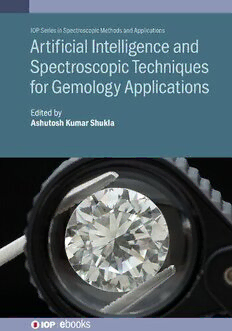Table Of ContentArtificial Intelligence and
Spectroscopic Techniques for
Gemology Applications
Online at: https://doi.org/10.1088/978-0-7503-3927-8
IOP Series in Spectroscopic Methods and Applications
Series Editor
Ashutosh Kumar Shukla, Ewing Christian College, Prayagraj, India
About the Series
TheIOPSeriesinSpectroscopicMethodsandApplicationsaimstodevelopalibrary
of key texts encompassing the broad range of spectroscopic techniques, instrumen-
tation and fields of applications found in modern science. Some examples of the
spectroscopic techniques incorporated include, IR, UV/VIS, Raman, EPR, NMR,
fluorescence spectroscopy, force spectroscopy, hyperspectral imaging, neutron
scattering,Mössbauerspectroscopy,photoemissionspectroscopyandallthevarious
specialist techniques within these broad domains and more. Microscopic character-
ization techniques may also be included where they are used in conjunction with
spectroscopic methods for sample analysis.
Theseriescontainstwobroadtypesofapproach.Thoseaddressingaparticularfield
ofapplicationandreviewsthenumerousrelevantspectroscopicmethodsapplicableto
the field, and those that focus on a specific spectroscopic method which will permit a
greater in-depth review of the theory and instrumentation technology.
A full list of titles published in this series can be found here: https://iopscience.iop.
org/bookListInfo/iop-series-in-spectroscopic-methods-and-applications.
Artificial Intelligence and
Spectroscopic Techniques for
Gemology Applications
Edited by
Ashutosh Kumar Shukla
Department of Physics, Ewing Christian College, Prayagraj, India
IOP Publishing, Bristol, UK
ªIOPPublishingLtd2022
Allrightsreserved.Nopartofthispublicationmaybereproduced,storedinaretrievalsystem
ortransmittedinanyformorbyanymeans,electronic,mechanical,photocopying,recording
orotherwise,withoutthepriorpermissionofthepublisher,orasexpresslypermittedbylawor
undertermsagreedwiththeappropriaterightsorganization.Multiplecopyingispermittedin
accordancewiththetermsoflicencesissuedbytheCopyrightLicensingAgency,theCopyright
ClearanceCentreandotherreproductionrightsorganizations.
PermissiontomakeuseofIOPPublishingcontentotherthanassetoutabovemaybesought
[email protected].
AshutoshKumarShuklahasassertedhisrighttobeidentifiedastheeditorofthisworkin
accordancewithsections77and78oftheCopyright,DesignsandPatentsAct1988.
ISBN 978-0-7503-3927-8(ebook)
ISBN 978-0-7503-3925-4(print)
ISBN 978-0-7503-3928-5(myPrint)
ISBN 978-0-7503-3926-1(mobi)
DOI 10.1088/978-0-7503-3927-8
Version:20221201
IOPebooks
BritishLibraryCataloguing-in-PublicationData:Acataloguerecordforthisbookisavailable
fromtheBritishLibrary.
PublishedbyIOPPublishing,whollyownedbyTheInstituteofPhysics,London
IOPPublishing,No.2TheDistillery,Glassfields,AvonStreet,Bristol,BS20GR,UK
USOffice:IOPPublishing,Inc.,190NorthIndependenceMallWest,Suite601,Philadelphia,
PA19106,USA
To my niece Anvesha.
Contents
Preface x
Editor biography xi
List of contributors xii
1 Laser-induced breakdown spectroscopy for gemological testing 1-1
Francesco Poggialini, Beatrice Campanella, Stefano Legnaioli,
Simona Raneri and Vincenzo Palleschi
1.1 Introduction 1-1
1.2 What is LIBS 1-2
1.3 Applications of LIBS in gemology 1-8
1.4 Conclusion 1-12
References 1-13
2 Raman spectroscopy for the non-destructive analysis of gemstones 2-1
Danilo Bersani, Laura Fornasini, Peter Vandenabeele and Anastasia Rousaki
2.1 Raman spectroscopy on gemstones 2-1
2.1.1 A short introduction to Raman spectroscopy 2-2
2.2 Benchtop and mobile Raman spectroscopy 2-3
2.3 Selected topics of Raman spectroscopy for gemological purposes, 2-7
including forgeries
2.3.1 Garnets 2-7
2.3.2 Jade 2-11
2.3.3 Beryls 2-14
2.3.4 Corundum and other gemstones 2-17
2.3.5 Raman and photoluminescence emission 2-19
2.3.6 Glass 2-20
2.3.7 Pearls and corals 2-21
2.3.8 Forgeries 2-26
2.4 Conclusions 2-32
References 2-33
3 Application of Fourier-transformed infrared spectroscopy and 3-1
machine learning algorithm for gem identification
Pimthong Thongnopkun, Kanet Wongravee, Prompong Pienpinijtham
and Aumaparn Phlayrahan
3.1 Introduction 3-1
vii
ArtificialIntelligenceandSpectroscopicTechniquesforGemologyApplications
3.2 Concept of IR spectroscopy 3-1
3.2.1 FT-IR sampling techniques for gem analysis 3-6
3.3 Diamond 3-8
3.3.1 Classification of diamond types 3-9
3.3.2 Characterization of synthetic diamonds and treated diamonds 3-13
3.3.3 Identification of diamond imitations 3-15
3.4 Rubies and sapphires 3-16
3.4.1 General information on rubies and sapphires 3-16
3.4.2 Application of FITR for corundum analysis 3-19
3.5 Emerald 3-23
3.5.1 Identification of natural and synthetic emeralds 3-24
3.5.2 Origin determination 3-26
3.5.3 Identification of resin-filled emeralds 3-27
3.6 Quartz 3-28
3.6.1 Identification of natural and synthetic quartz 3-29
3.6.2 Characterization of heat treatment and irradiation 3-30
3.7 Jade 3-30
3.7.1 Identification of jade enhancement 3-31
3.8 Turquoise 3-32
3.8.1 Characterization of turquoise 3-33
3.8.2 Identification of treated and imitated turquoise 3-34
3.9 Application of machine learning algorithm to gemstone classification 3-35
3.10 Conclusions 3-50
References 3-50
4 A ruby stone grading inspection using an optical tomography 4-1
system
Syarfa Najihah Raisin, Juliza Jamaludin and Fatinah Mohd Rahalim
4.1 Introduction 4-1
4.2 Methodology 4-3
4.2.1 Mathematical expression 4-3
4.2.2 Image reconstruction 4-6
4.3 Results and discussion 4-6
4.3.1 Analysis on image reconstruction 4-7
4.3.2 Statistical ANOVA test analysis 4-8
4.4 Conclusion 4-13
References 4-13
viii
ArtificialIntelligenceandSpectroscopicTechniquesforGemologyApplications
5 Trace elements and big data application to gemology by x-ray 5-1
fluorescence
Yujie Gao, Moqing Lin, Xu Li and Xueying Sun
5.1 Introduction to XRF technique 5-2
5.1.1 The fundamentals of XRF 5-2
5.1.2 The advantages of XRF 5-3
5.2 Trace elements and analysis in gemstones 5-5
5.3 Case study of XRF and big data gemology 5-7
5.3.1 Identification of species and varieties 5-7
5.3.2 Color origin and fluorescence 5-13
5.3.3 Treatment detection 5-18
5.4 Big data application in gemology: geographic origin determination 5-20
5.4.1 Ruby 5-20
5.4.2 Spinel 5-24
References and further reading 5-28
ix

